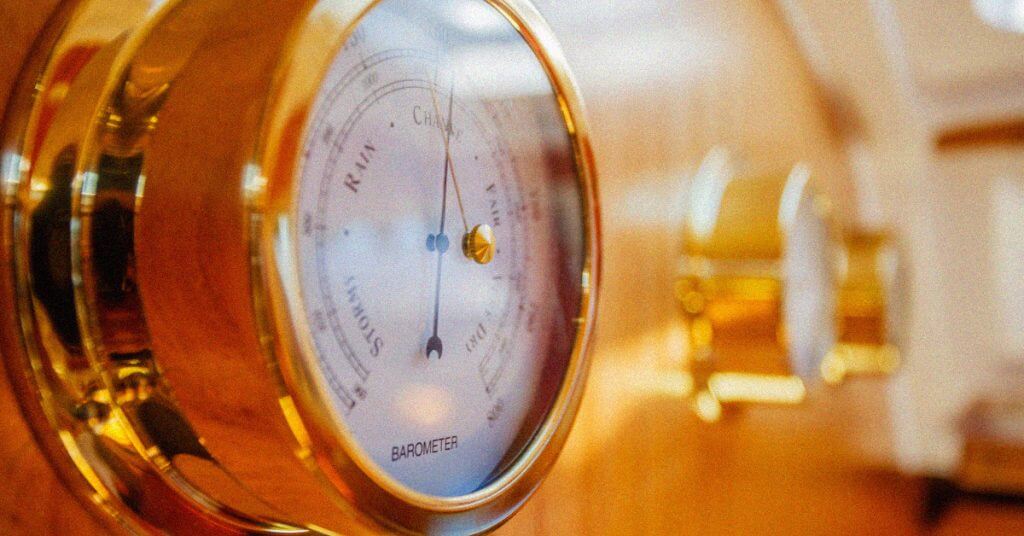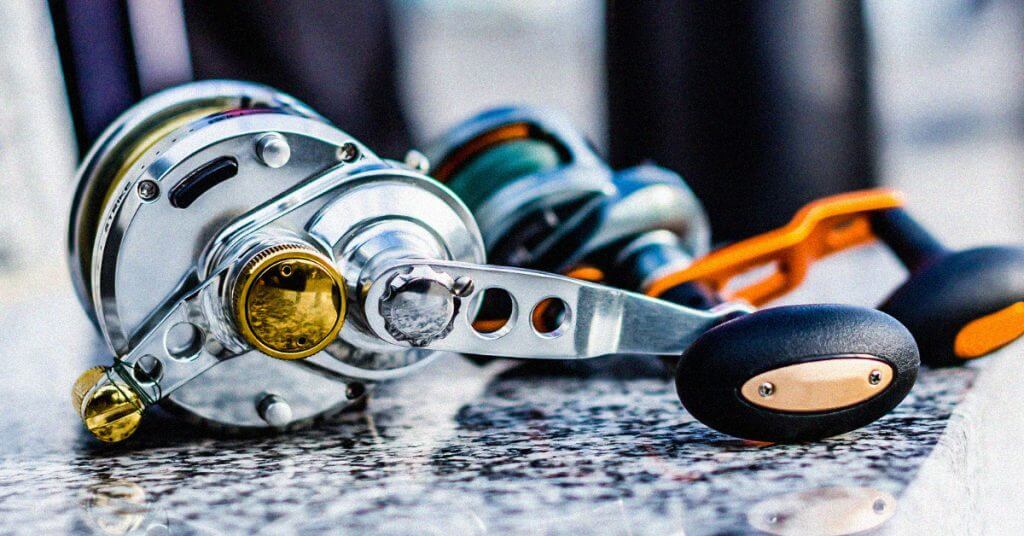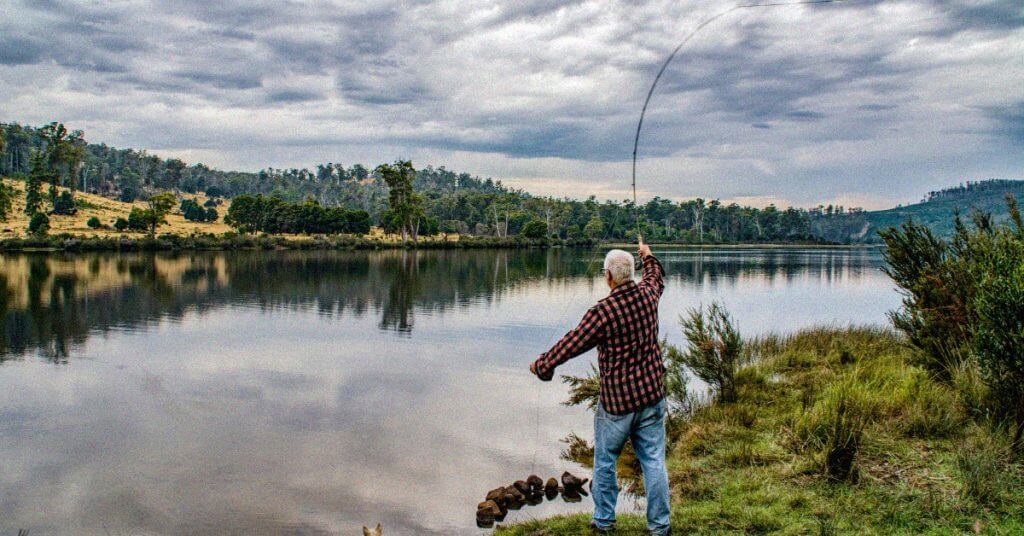Ice fishing for bass is something that most people never get to experience. They think it’s impossible, a waste of time, and frustrating. I’m here to tell you, don’t limit yourself! There are plenty of ways to catch bass in the winter with the right rod, line, lures, and strategy.
I’ve spent many winters on the ice in Pennsylvania, and while bass weren’t my usual target, they made their presence known. Now it’s time to catch ‘em!
Where and When to Go Ice Fishing for Bass?
The first and most important thing to understand about ice fishing for bass is that largemouth and smallmouth bass have different habits. They maintain different zones in the water, and each of these zones has its own qualities.
Largemouth bass like to hang around soft weedy areas, and they don’t usually go much deeper than 30 feet. If it’s a mild winter or you’re experiencing a warm front coming through, expect them to be even more shallow.
On the other hand, smallmouth lean towards hard rocky bottoms, and they go a bit deeper at around 40 feet but will come up to shallow water when the temperature is warm as well.
Just because there’s ice on the water doesn’t mean the bass aren’t active underneath. Anytime you get a little bit of warmth supplied from the sun and air, the bass increase their activity.
When this changes is when the cold fronts move through and bring below-freezing temperatures. Now the bass will start to retreat away from cold water towards deeper water where it’s “warmer.”
If you’re fishing in rivers, expect to find mostly largemouth without any smallmouth around. The smallies tend to stay dormant all winter long in rivers while the largemouth can continue to move around and stay active.
When the weather warms up a little to around freezing, expect both species to come into more shallow water to feed. Most of them are looking for minnows, shiners, shad, and other baitfish, so you’ll want to try and pay attention to what’s going on in the lake before it freezes over and pick your lures appropriately.
For general recommendations on what lures to use, take a look at our two following articles depending on what you’re targeting.
Location, Location, Location
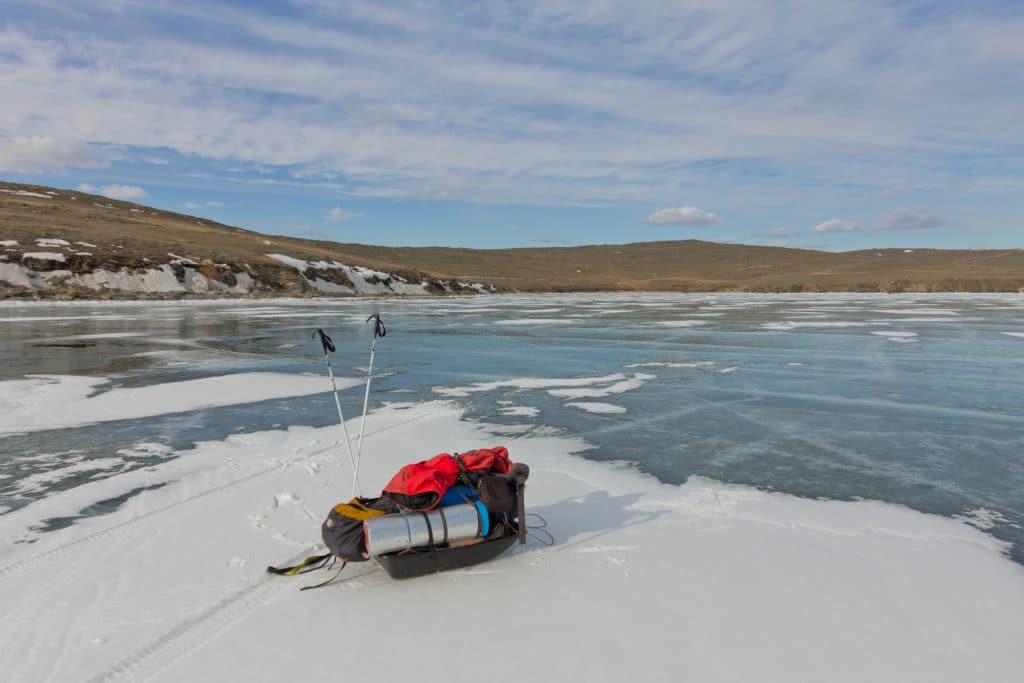
Let’s try and get a little more specific to help you out there. It all depends on what kind of lake you’re fishing when you’re trying to find bass under the ice. If you’re fishing a big lake, you want to look for places that would normally house weed beds when the water was running free. The largemouth will still hug this area at around 25 feet, much deeper than you’re used to.
Smallmouths are after harder structure such as rock piles and stumps. They’ll rise up when the temperature levels out a little but retreat back down to around 30 feet when things get cold.
You can expect to find them around vertical structure like stumps, and any time you get a warm-up, target smallies around flats of less than ten feet because they’ll make a dramatic move upward to try and feed while they can.
Ice fishing for smallmouth is never easy, so I recommend sticking with largemouth. They’re easier to find, and they almost always cruise around the same area. Most largemouth will occupy the area a few feet from the bottom all throughout the winter.
Necessary Ice Fishing Gear
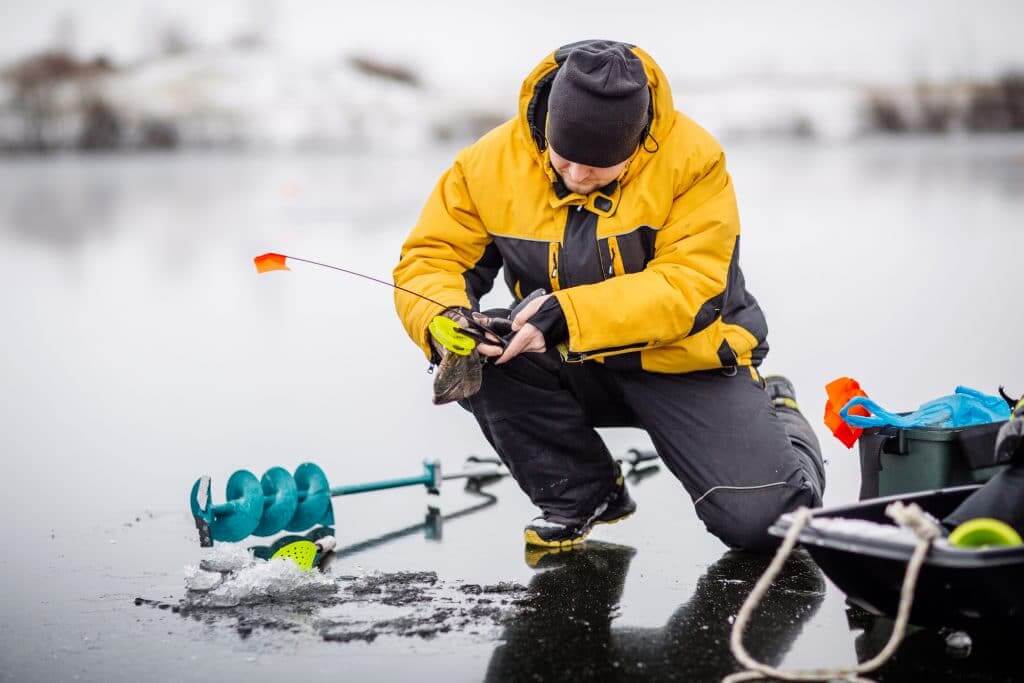
If there’s one thing unfamiliar ice anglers confuse, it’s what you need to bring with you to fish. The times have changed, and the water is a sheet of ice now; this requires a completely different approach if you’re not only going to catch something but be able to stand being on the ice long enough.
Let’s take a look at some of the ice fishing gear you need for bass fishing.
Rod Style
Bass are more mellow during the winter, so you don’t need as much power behind you as you would during the summer. I can never understand why some anglers recommend going with a longer rod because I find it unnecessary and a burden. If you’re using an ice fishing shelter, you can’t possibly go out there with a seven-foot rod – it just won’t happen.
Go with a short, fast action, light power rod when fishing for bass during the winter. They’re slower, and they won’t set the hook as hard. The fast action will ensure you get a nice hook set even when the bass are nibbling, and the short rod allows you to fish inside a shelter.
Rod Material
Choosing the right blank material for your rod is equally as important as it’s style. You’re basically choosing between graphite and fiberglass at this day in age, so it’s important to pair sensitivity with durability. You want to get the most for your money and have a rod that’s both sensitive and strong.
Graphite is highly sensitive, durable, and great at creating the perfect presentation because it’ll move on every slight movement you make. But they’re more expensive than fiberglass.
Fiberglass is not as sensitive, but it’s more flexible, which is important for setting the hook. All-in-all, most rods are made to be relatively equal, and if you’re deadsticking, fiberglass is plenty good enough.
Guides and Line
The eyes or guides are one of the most critical components on an ice fishing rod, and when you pair that with the line you choose, you’re looking at two really crucial aspects of ice fishing for bass.
Here’s why:
The more guides, the more uniform flexibility on the rod. That means you’ll get better shock absorption, which is important in ice fishing. Look for a rod blank with at least five guides that taper away from you to the tip.
You want the guides to be a bit larger than usual as well. Keep in mind that water will build up on the guides and freeze, so the larger the eyes, the fewer times you need to clean them off.
As for lines, you’ll want to get a dedicated ice fishing line. These are resistant against the extreme cold so they won’t get brittle. Traditional monofilament or braided will get brittle if you’re out on the water for an extended period of time, and you don’t want that. Make sure you always change your line out too when you come home. Don’t reuse the ice fishing line.
Ice Fishing Lures for Bass
Jigging is the most popular method of ice fishing for bass because it doesn’t require a lot of flexibility in the rod, which works well with ice fishing line. You will need to use a little finesse though. If you’re using monofilament, you might want to choose a slightly heavier lure than if you’re using braided.
I would suggest going with a standard tube jig or some form of split tail jig in a neutral color. You want to mimic the color to whatever the bass is feeling, so it’s going to be very important to pay attention to this.
Augers
You’ll have a hard time ice fishing for bass if you can’t drill a hole. An ice auger is an important tool, and you’ve got a few different avenues you can go. If you want to sit there and struggle all day, you can go for a manual hand auger. I would not recommend it because you have to turn it manually, and there are better options that don’t cost too much.
I prefer drill auger attachments that you can hook up to a power drill, and it looks a lot like a long wood bit. These work well, but they’re not the best choice for larger holes.
If you’re going all-in on ice fishing, you’ll want a power auger. The only thing you need to make sure of is that the ice is around six inches or thicker.
It’s technically safe to drill ice approximately four inches in depth, but I would never chance that. At six inches, the ice is thick enough to drive an ATV on so it can handle the vibration of a gas-powered auger.
Ice Fishing Bib
If you want to stay warm on the ice then I highly, highly suggest getting an ice fishing bib. These are going to be a lifesaver and will also allow you to stay out on the ice longer and in turn, allow you to (hopefully) catch more fish.
If you’re in the market for a bib then read our article about the best ice fishing bibs where we go over them in detail.
Ice Fishing Techniques for Catching Bass
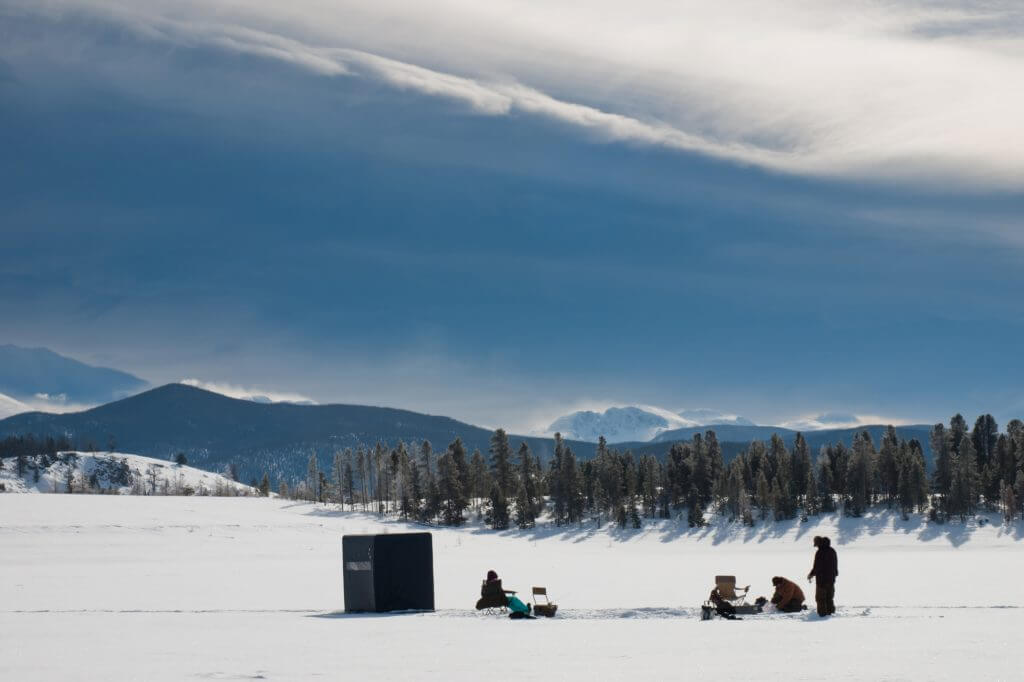
The most popular bass fishing technique on the ice is called a “pop and drop.” You might have heard it called something else, but this is the strategy I use, and it’s paid off plenty of times.
It’s very simple. All you need to do is drop your jig in the water and let it fall to the bottom. Lift your rod tip about eight or nine inches and let it drop again. You want to keep doing this about 30 times and if you don’t get a hit after that, try slowing it down and speeding it up.
While we think consistency is always the key to success in bass fishing, that’s not always true. If one thing isn’t working, we need to try a slight variation of that one thing.
I think using live bait is also pretty smart with ice fishing for bass. Use a standard jig head and throw some maggots or wax worms on there.
Keep in mind that you can size everything down as well. The bass’s metabolism is extremely low right now, so they’re not feeding much, and when they do, you need to put it right in their face and don’t make it much of a challenge.
Use a smaller jig with as little as a two-pound test line, which might seem crazy, but it’ll work better during the winter.
Tip-ups are also a popular ice fishing strategy. These work great along drop-offs, especially if you’re using an ice fishing fish finder or underwater camera.
Assemble a tip-up and fish it in the open water using small jigs, Berkley soft plastics, or live bait. If you can get a few of these placed all over the water, you’re bound to find some big fish.
Winter Bass Fishing Tactics
Here are some of my best winter bass fishing tips. Keep these in mind when you hit the ice:
Bring a Sled
In most cases, you won’t be able to drive your car onto the ice. Unless you’re really confident and you’re fishing unsupervised waters, most state ponds won’t allow you to drive your vehicle out there, and they highly recommend against it.
If that’s the case, you need a method to bring your gear onto the ice. You may have to travel as far as a half-mile or longer to get to your location and the last thing you want to do is make multiple trips.
By bringing a long sled with a rope, you can throw your tackle box, rods, and other gear into the shed, making it much easier to get it out there.
And if you’re really going to get into the sport, I suggest buying a dedicated ice fishing sled to make your life easier!
Fish Deeper Than Usual
I always preach shallow, shoreline, shallow, but that doesn’t apply here. You want to change up your strategy and go to the water’s deepest areas because they’re the warmest. Warmer water is denser than colder water, so it sinks to the bottom, and that’s where the bass hang out all winter.
Go Early
Getting on the ice at the crack of dawn is the key to a successful trip. If your goal is to catch bass, then you’ll have to get there early. Catch some bass and panfish like bluegills and crappie before 10am and then switch over to some heavier fishing tackle and try to pull in a few walleye or musky.
Slow it Down
You need to present your jig as slow as humanly possible, so you don’t challenge the bass. They’re not looking to chase your lure across the pond so when it hits bottom, let it sit there for a bit. When you feel a little weight on your line, give it a jerk, and set the hook.
Final Thoughts
So, are you ready to brave the cold and take on some ice fishing for bass this year? Knowing how to ice fish for bass is simple as long as you understand how the cold impacts their behavior. Most people think you can’t catch bass in the winter, but the problem is, they don’t know how, so they think it’s impossible.
There are plenty of other species to target in the winter as well, so don’t limit yourself to bass fishing. Be safe, be smart, and always bundle up more than you think you need to. When you’re out in the middle of the lake, you don’t have any protection from the blistering wind.
Some of the best fishing and greatest opportunities to catch fish come when the temperature drops below freezing!

